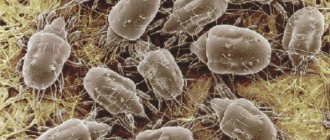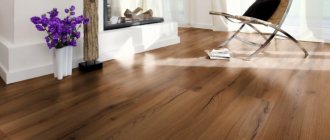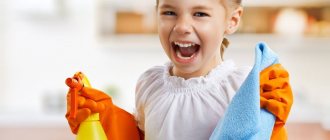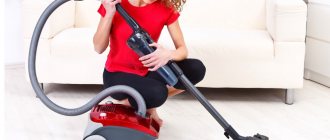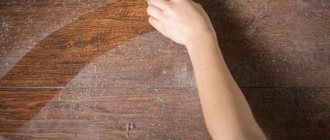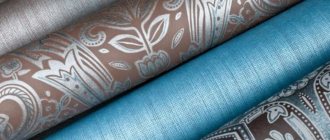After wet cleaning, within a few hours all surfaces are again covered with a thin layer of dust. Moreover, this happens both with the windows wide open and with the vents and doors tightly closed. Nothing can be done about dust settling, but there are ways to minimize this process, which is very important for people suffering from allergies or diseases of the bronchopulmonary system. Let's figure out where dust comes from and what ways to deal with it.
Let's start with the definition
First, let's find out what dust is. These are solid small particles ranging in size from 0.01 to 10 microns. Dust particles no more than 0.1 mm. Anything that exceeds this size already goes into the category of sand.
The smallest particles fly in the air, gradually settling on the floor and vertical surfaces of the apartment. Large elements contained in dust settle immediately.
Danger
Before we look at the composition of house dust in detail, let’s find out what danger it poses to humans. Dust and the components it contains cause an allergic reaction in humans. Allergy sufferers are especially affected.
But allergies are not the worst thing. Dust can cause a lot of diseases, silicosis, asthma and others. These are dangerous diseases from the group of pneumoconiosis, as well as various types of infectious diseases.
Dust may contain heavy metals. Their composition in the apartment directly depends on the production located near the house. These components can also cause serious illness in humans and pets.
Dust composition
Dust is a heterogeneous substance, and many different components, organic and mineral origin, are involved in its formation. We'll look into everything in detail.
Human skin
Just imagine that three members of an average family produce 1 kg of dust per month. A person adds dead particles of his own skin to the dust.
Over the course of a year, a person “sheds” from 400 to 450 grams of dead skin tissue. It settles on the floor, vertical surfaces, and gets clogged up in upholstered furniture and bed linen. Hair loss is added to the skin.
Dirt and grease
From the street, dirt, consisting of a mixture of small particles of sand and natural fats, gets into the house on our shoes. Sand accumulates, generally in soft carpets. The main danger of this component is its ability to destroy carpets and hard surfaces in the house.
Surely, you have noticed the process of “balding the carpet.” So this is the impact of sand and our walking. Fats act as a connector in dust. Fats bind various elements, which interferes with cleaning.
Pollen
This component can be produced by flowering house plants, and can also enter the apartment through open windows. People bring pollen on clothes and shoes.
May enter through ventilation and air conditioning systems. If wet cleaning of premises is not done regularly, pollen accumulates and causes allergies. This danger is especially annoying during the flowering period. The problem is that cloth vacuum cleaners only remove part of the pollen, while the rest rises into the air and then settles again.
Pet hair
If dogs, cats and other animals live in the house, then their hair is necessarily added to the dust. Animals have periods of shedding in their life cycle, and some species experience hair loss year-round.
This also applies to birds. The products of their vital activity, feathers and fluff, also remain in the apartment, becoming part of the dust. In addition, there are many syncretic creatures in the house, in the form of spiders and insects, which also leave their mark.
Ticks
The main element, and also live, of house dust is mites. Studies have shown that they account for 80% of the content of dust deposits. This is also the most harmful substance. There is a lot of food for them in the dust. These are organic compounds, particles of our skin, pet hair.
House ticks do not bite, and therefore are not dangerous in themselves. But their waste products can cause serious harm to health. The most common reaction to the presence of mites is an allergy. Like any insect, ticks can be carriers of infectious diseases.
Fungi
Mold is another element of house dust. Typically, mold is found in air masses, but in interaction with other particles, it settles on the surface.
Mold spores, like mite excrement, cause allergic reactions. Mold compounds form entire colonies in different parts of the apartment, on the walls, furniture. A particularly favorable environment for them is the bathroom, where there is high humidity.
The entire periodic table
Dust has peculiar properties. One of them is the attraction and absorption of various substances, including those classified as harmful. The composition also includes fiberglass, particles of fabric, paper, particles that fall from the ceiling and walls of the apartment, furniture and household items.
Laboratory studies have shown that the dust contains more than half of the elements included in the periodic table of chemical elements and about a hundred different organic compounds. Harmful impurities can cause disease, and therefore it is necessary to regularly clean residential premises.
Bacteria
The smallest microorganisms of living nature, viruses and bacteria, cannot move independently. They use small dust particles as a means of transportation, spreading throughout the entire space of the apartment or house.
In one thimble of house dust, using a powerful microscope, we were able to find out a disappointing figure. This thimble contains five million microbes, including causative agents of allergies and dangerous diseases.
Humidifier
Insufficient levels of air humidity negatively affect human health, lowering immunity, and also causing drying of the mucous membranes. It is especially important to monitor humidity in winter, during the heating period. The most effective assistant in this matter is an air humidifier, which has several varieties.
| Classical | operates using cold evaporation. The liquid is poured into a special container, after which it evaporates under the influence of a stream of cold air generated by a fan. Moreover, the lower the humidity, the faster evaporation occurs. |
| Steam | The poured water, under the influence of high temperatures, reaches a boil and steams. The design is quite safe; hot water will not spill out, even if the device turns over or falls. This type of humidifier is convenient to use because it is highly efficient and does not require periodic replacement of additional elements (cartridges, plates, etc.). However, there is also a drawback - a high level of electricity consumption. |
| Ultrasonic | Under the influence of high-frequency vibrations, water is sprayed into microscopic particles. With the help of a fan, cold and moist fog enters the dry air of the room. |
The optimal humidity level in residential premises is 45-60%.
Every corner of the apartment has its own dust
Laboratory research and an experiment by one American journalist showed that the composition of dust differs in different parts of an apartment or house.
The corridors and hallways contain more elements brought from the street. Under the beds there are the most different types of mites and bacteria. In the kitchen, the composition includes organic compounds and molecules of chemical elements used to clean dishes and surfaces.
Scientists also found that dust and the elements it contains enter the apartment from the air. We bring much less of it on our shoes and clothes.
Time-tested people's advice
Modern housewives know many ways and means of getting rid of dust in the apartment:
Cleaning from top to bottom
This is necessary to prevent dust from falling onto the cleaned surfaces from above. Always start dusting from the top.
Closed window
Ventilating the apartment several times a day is necessary, but you should not forget that you should not keep the windows open all the time, since a large amount of dust enters the apartment with the street air.
It should also be remembered that mosquito nets on the windows are an excellent assistant for the modern housewife; they can protect the apartment from the entry of more dust.
- Covers for storing clothes. They are essential for storing things you rarely use. These are seasonal clothes, blankets, pillows, blankets and other small items.
- Alcohol solution. All light bulbs in the apartment must be treated with a cloth moistened with an alcohol solution. This will help dust settle on them in much smaller quantities.
- Cleaning the vacuum cleaner and hood. It is necessary to ensure the cleanliness of the vacuum cleaner filters. Since a dirty filter contributes to the release of a large amount of dust into the air of the apartment. You should not forget to clean the grills on the hood in the kitchen and bathroom at least once every two weeks. It is on them that a huge amount of dust accumulates.
- Fight the carpets. Carpets are real dust collectors in homes. They need to be vacuumed several times a day. It's better not to buy them at all. If carpets are necessary, then it is better to purchase them from natural material. After all, synthetics attract dust.
- Caring for indoor plants. Houseplants help purify the air in your apartment. In order for them to cope better with their function, keep the leaves of the plants and the pots in which they grow clean.
Fabric softener
There will be less dust in the apartment thanks to a solution prepared from fabric softener. Dust will accumulate less on treated surfaces.
- To prepare it, you need to take a spray bottle, fill it with 150 milliliters of clean water and 50 milliliters of any fabric softener.
- Spray the prepared solution onto the surfaces needed for treatment and wipe dry with a cloth.
Cleaning roller for clothes
Thanks to its sticky structure, it will help remove dust from fabric surfaces and lampshades. This will significantly reduce cleaning time.
Cosmetic brushes
In order to remove dust from small objects and in hard-to-reach places, you need to use a cosmetic brush. The natural pile of which will perfectly attract dust particles.
By following these simple rules, there will be much less dust in the apartment, the air will become cleaner and the mood of the household will improve significantly.
How to get rid of dust
Humanity has learned to effectively get rid of dust, but scientists make pessimistic forecasts that it is simply impossible to completely get rid of it.
The most effective and common method is wet cleaning using dust collection agents. After collecting dust with a vacuum cleaner or after using a broom, after a while it is necessary to wipe the floor and surfaces in the apartment, since some of the dust will settle again after the vacuum cleaner.
Room cleaning must be done from top to bottom. This method will destroy more dust. Every day, brush off surfaces in the house with napkins, rags and special brushes to collect dust. It is necessary to regularly wash clothes and soft fabrics in the apartment (blankets, bedspreads, blankets), as these are also excellent dust collectors.
Another effective way is to install air purification systems. Nowadays several types of control are used: apartment humidifiers, purifiers and the most advanced - air “washes”. They collect dust, moisten it and throw it back. They also ionize rooms using special lamps. The dust is not removed, but its harmful properties are reduced.
Apartment “dust collectors”
Soft toys, figurines, decorative plants - such little things make our home more comfortable. At the same time, they accumulate dust. Of course, there is no need to throw away your favorite things - just store them correctly.
- Cushioned furniture. Dust likes to settle and accumulate in textile fibers. Such furniture, as well as sofa cushions and thick curtains, need to be vacuumed regularly. Use special attachments to clean hard-to-reach areas.
- Carpet covering. When walking, dust from it rises back into the air and is inhaled by the lungs. Carpets should be vacuumed every week and, if possible, shaken out.
- A rug near the front door. Dangerous bacteria from the street remain on it, so do not forget to systematically clean it.
- Bed sheets. Wash it regularly and steam it. An excellent solution would be to use mattress covers.
- Old clothes, plush toys. Give away unused items, and wash used items more often. The less unnecessary textiles, the cleaner the house.
- Decorative elements. It is better to store figurines, vases and other things in boxes or on closed shelves behind glass. Leave a few items for decoration, and the rest should be packed and put away in the closet.
- Houseplants. Dirt from the leaves should be wiped regularly with a cloth. Green spaces ventilate the air well and help fight dust.
- Pets. Brush cats and dogs weekly; this should be done in the bathroom so that the hair does not fly around the apartment.
